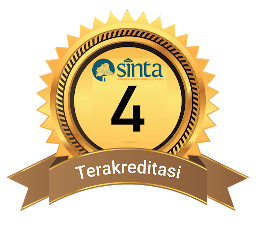Development of Contextual Based E-LKPD on Acid Base Topic
DOI:
10.29303/cep.v7i2.5687Published:
2024-12-04Issue:
Vol. 7 No. 2 (2024): Edisi NovemberKeywords:
Development, E-LKPD, contextual, acid-baseArticles
Downloads
How to Cite
Abstract
The purpose of the study is to determine: 1) the characteristics of the developed contextually-based E-LKPD on acid-base topic and 2) the level of validity and practicality of contextually-based E-LKPD on acid-base topic. This research is a Research and Development research with a 4D research model (define, design, develop, disseminate). The population in this study were students of class XI IPA SMAN 1 Kediri with a sample of the entire population, namely 42 students because the population were relatively small or less than 100. The results showed that the validity value obtained using the Aiken index (V) was 0.84 in the very category of valid. The level of practicality is measured through student responses to the contextually based E-LKPD. The results of the student response analysis are in the very practical category with a practicality percentage of 91%. Based on these results it can be concluded that the contextually based E-LKPD on acid-base topic developed is feasible and practical for used in learning because it meets the valid and practical categories.
References
Andriani, M., Muhali, & Dewi, C.A. (2019). Pengembangan Modul Kimia Berbasis Kontekstual Untuk Membangun Pemahaman Konsep Peserta didik Pada Materi Asam Basa. Hydrogen: Jurnal Kependidikan Kimia, 7(1), 26-27.
Arikunto, S. (2010). Metode Penelitian: Prosedur Penelitian Suatu Pendekatan Praktik. Jakarta: Rineka Cipta.
Daryanto. (2013). Menyusun Modul Bahan Ajar untuk Persiapan Guru dalam Mengajar. Yogyakarta: Gava Media.
Depdiknas.(2008). Panduan Pengembangan Bahan Ajar. Jakarta: Departmen Pendidikan Nasional.
Ningsih., Wirda, S., dkk. (2017). Pengembangan Perangkat Pembelajaran dengan Pendekatan Contextual Teaching and Learning untuk Meningkatkan Kemampuan Pemecah Masalah Peserta Didik Kelas XI. Jurnal Nasional Pendidikan Matematika. 2 (1).
Purnama, S. (2013). Metode Penelitian dan Pengembangan (Pengenalan untuk Mengembangkan Produk Pembelajaran Bahasa Arab). Jurnal LITERASI, 4(1), 19- 32.
Puspitasari, A. D. (2019). Penerapan Media Pembelajaran Fisika Menggunakan Modul Cetak dan Modul Elektronik pada Siswa SMA. Jurnal Pendidikan Fisika. 7 (1), 17-25.
Retnawati, H. (2016). Validitas Reliabilitas dan Karakteristik (Panduan untuk Peneliti, Mahasiswa, dan Psikometrian).
Riduwan. (2009). Metode dan Teknik Menyusun Tesis. Bandung: Alfabeta.
Rodi., Masykuri, M., & Sukarmin. (2017). Pengembangan Modul Pembelajaran Fisika SMA Berbasis Contextual Teaching and Learning (CTL) Terintegrasi Pendidikan Karakter Pada Materi Hukum Newton Tentang Gerak dan Penerapannya. Jurnal Inkuiri. 6 (2).
Sholehah, F. (2021). Pengembangan E-LKPD Berbasis Kontekstual Menggunakan Liveworksheets Pada Materi Aritmetika Sosial Kelas VII SMP Ahmad Dahlan Kota Jambi. Jambi: UIN Sulthan Thaha Saifuddin Jambi.
Sugiyono, P. D. (2019). Metode Penelitian Pendidikan (Kuantitatif, Kualitatif, Kombinasi, R&D, dan Penelitian Pendidikan). Jakarta: PT. Rineka Cipta.
Sugiyono. (2012). Metode Penelitian Kuantitatif Kualitatif dan R & D. Bandung: Alfabeta.
Suyanti, R. D. (2010). Strategi pembelajaran kimia. Yogyakarta: Graha Ilmu.
Thiagarajan, S., Semmel, D. S., & Semmel, M. I. (1974). Instruction Development for Training Teachers of Exeptional Children (9725 ed). Minncapolis: Indiana University.
Trianto. (2013). Mendesain Model Pembelajaran Inovatif, Progresif, Konsep, Landasan, dan Implementasinya Pada Kurikulum Tingkat Satuan Pendidikan (KTSP). Kencana Prenada Media Group.
Yuliandriati, Susilawati, & Rozalinda. (2019). Pengembangan Lembar Kerja Peserta Didik Berbasis Problem Based Learning pada Materi Ikatan Kimia Kelas X. Jurnal Tadris Kimia, 1(4): 105-120.
Zakirman., & Hidayati. (2017). Praktikalitas Media Video dan Animasi dalam Pembelajaran Fisika di SMP. Jurnal Ilmiah Pendidikan Fisika Al-BiRuNi. 6 (1): 85-93.
Author Biographies
Rizkia Amalia Fitri, Mahasiswa
Yunita Arian Sani Anwar, Program Studi Pendidikan Kimia, FKIP, Universitas Mataram
Eka Junaidi, Program Studi Pendidikan Kimia, FKIP, Universitas Mataram
License
Copyright (c) 2024 Rizkia Amalia Fitri, Yunita Arian Sani Anwar, Eka Junaidi

This work is licensed under a Creative Commons Attribution-ShareAlike 4.0 International License.
Authors who publish with Chemistry Education Practice agree to the following terms:
- Authors retain copyright and grant the journal right of first publication with the work simultaneously licensed under a Creative Commons Attribution License 4.0 International License (CC-BY-SA License). This license allows authors to use all articles, data sets, graphics, and appendices in data mining applications, search engines, web sites, blogs, and other platforms by providing an appropriate reference. The journal allows the author(s) to hold the copyright without restrictions and will retain publishing rights without restrictions.
- Authors are able to enter into separate, additional contractual arrangements for the non-exclusive distribution of the journal's published version of the work (e.g., post it to an institutional repository or publish it in a book), with an acknowledgement of its initial publication in Chemistry Education Practice.
- Authors are permitted and encouraged to post their work online (e.g., in institutional repositories or on their website) prior to and during the submission process, as it can lead to productive exchanges, as well as earlier and greater citation of published work (See The Effect of Open Access).






